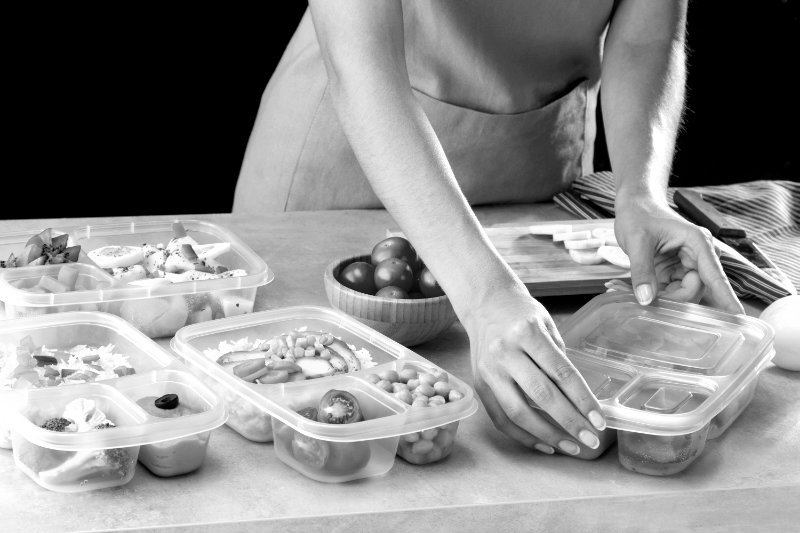Do you feel like you’re juggling too many things like work, daily chores, and family duties? Like you’re always short on time? After a long day of work, putting together a healthy, home-cooked meal often feels impossible. Not to mention the overflowing fridge and the forgotten vegetables in the drawer, adding to the guilt.
But what if there was another way? A way that could help you simplify your cooking routine, save precious time, and reduce food waste. Look no further. This is where minimalist meal prep comes in. This way, you can plan stress-free, delicious, and easy healthy meals. Plus, a well-planned minimalist meal prep can help you with all your kitchen problems, from nutrition to food waste.
Minimalist meal prep isn’t about preparing detailed dishes; it’s about simplifying food preparation while maintaining quality. This article will help you gain the knowledge and inspiration to embrace minimalist meal prep.
Principles of minimalist meal preps
The beauty of minimalist meal preparation lies in its use of basic ingredients that can be used in a variety of ways while reducing waste. You can cook healthy meals by focusing on a few items and planning smart. Here’s what you need to keep in mind while preparing a meal plan:
Grocery shopping
Start by planning for the week by making a list of ingredients that you’ll need for the recipes. Focus on the recipes that use common ingredients; that way, you can simply use them for multiple dishes. Also, instead of filling up your cart with extra ingredients, select seasonal veggies.
Main ingredients
For the ingredients, choose different sources of protein, such as chicken breasts or tofu, whole grains like brown rice, and a range of veggies, such as broccoli. These various ingredients can be combined in many different ways to create easy meals.
Ingredient organization
It’s crucial to keep your ingredients organized. Store your cooked meals in sealed containers to keep them fresh all week. Consider getting airtight containers for storing meals and leftovers.
Read more: Savor, Scrap, Soil: From Food Waste to Compost
Minimalist meal prep recipes
While minimalist cooking takes a simple approach by focusing on a few key ingredients, traditional meals often involve a variety of ingredients and dishes. Although the methods may differ in their approaches, they are unique in how they each focus on meal planning.
Traditional cooking may be hearty and plentiful, but minimalist cooking can create easy, healthy meals without spending hours cooking in the kitchen. Here are a few examples of minimalist recipes to inspire you:
Sheet Pan Lemon Garlic Chicken and Roasted Veggies
This recipe is a perfect example of minimal cooking. It only needs one pan and ingredients for a fulfilling meal. Follow the steps below to create this meal:
Ingredients:
- 2 boneless or skinless chicken breasts
- 1 tablespoon of olive oil
- 1 teaspoon of dried oregano
- ½ teaspoon of garlic powder
- ½ teaspoon of salt
- ¼ teaspoon of black pepper
- 1 sliced red bell pepper
- 1 sliced green bell pepper
- 1 sliced red onion
- 1 broccoli crown, cut into tiny pieces
- 1 lemon
Instructions:
- Prepare a baking tray.
- Place your baking sheet.
- Warm up your oven to 400°F (200°C) for 15-20 minutes.
- Mix chicken breasts with all the spices in a different bowl.
- Make sure the chicken cuts are completely soaked.
- Once done, arrange the chicken and vegetables on the baking tray.
- Cook until chicken and veggies are well done.
- Return the tray to the oven and bake for another 25 – 30 minutes.
- For the final garnish, squeeze some lemon juice over the chicken.
- There you have it! You can now enjoy your dinner.
Vegetarian Buddha Bowls
Buddha bowls, also known as hippie bowls, are well-balanced and nutrient-rich one-bowl meals. Common ingredients include whole grains, proteins, and raw and roasted vegetables, which are usually topped with dressings and a variety of seeds.
Whole grains like millet, quinoa, brown rice, and buckwheat are high in fiber, vitamin B, and minerals. Studies have shown that including whole grains in your daily diet reduces the risk of stroke and other benefits like heart disease and type 2 diabetes. Here’s how you can prepare it:
Ingredients:
- Base: 1 cup of cooked brown rice, quinoa, or chopped romaine lettuce
- Protein: 1 can of drained and rinsed chickpeas, lentils, or grilled tofu cubes
- Veggies: ½ cup of roasted vegetables (see recipe 1) or any combination of chopped raw veggies like carrots, cucumber, and cherry tomatoes
- Toppings: Chopped pieces of fresh herbs, crumbled feta cheese, a drizzle of balsamic glaze, or your favorite sauce
Directions:
- Start by cooking your chosen base.
- Prepare your protein – chickpeas, lentils, or tofu.
- Add your favorite sauce to your protein, and then cook until ready.
- Roast your vegetables or chop them into bite-sized pieces.
- Finally, fill your bowls with veggies, then add your protein and any desired toppings.
Lentil and Vegetable Soup
This hearty soup made of lentils and vegetables is packed with protein and fiber, making it a satisfying and healthy meal option. It is a one-pot meal that fills you up, and several studies have found that it has many health benefits.
A 2019 study found that individuals who ate a diet rich in healthy plant foods lowered their risk of dying from heart disease and other causes. According to the National Institutes of Health (NIH), lentils rank among the top food sources for potassium, which is important in maintaining organs (such as your kidneys and heart), muscles, and nervous system.
Here are the list of ingredients and instructions for preparing this wholesome soup:
Ingredients:
- 1 tablespoon of olive oil
- 1 diced onion
- 2 diced carrots
- 2 diced celery stalks
- 2 minced cloves garlic
- 1 teaspoon of ground cumin
- ½ teaspoon of dried thyme
- 1 cup of rinsed brown lentils
- 4 cups of vegetable broth
- 1 (14.5 oz) can undrained diced tomatoes
- 1 cup of chopped kale or spinach
- Salt and pepper to taste
Instructions:
- Heat the olive oil in a large saucepan over medium heat.
- Add the vegetables and cook until tender or for 5 minutes.
- Add garlic, cumin, and thyme, and cook for a minute more.
- Put in cut tomatoes, vegetable broth, and lentils.
- Boil the ingredients in the pan for 20 to 25 minutes.
- Remember to add spinach or kale and cook until soft.
- Finally, season them with salt and pepper.
Once done, serve the soup immediately or store it in airtight containers in the fridge. It’ll stay good for up to five days and be ready whenever you need it during the week!
In conclusion
Cooking healthy meals every day is helpful, but it takes a lot of time and effort. But this is no longer the case with minimalist meal prep, as you can plan meals for the week.
Additionally, minimalist meal planning is an eco-friendly and practical way to reduce waste while eating healthy. With healthy minimalist meals, you can try out several healthy few-ingredient recipes. Moreover, you can save your money on groceries by focusing on basic ingredients and recipes.
So, let go of stress as you enjoy meals and embrace the minimalist magic! Reduce your cooking time to enjoy tasty, healthy meals throughout the week. Plan your meals, fill your cupboard with customizable necessities, and dive into the world of minimalist recipes.
If you would like to see more resources on waste minimization, check out the Home Organization Science Labs. The lab uses the research of the Institute for Life Management Science Labs to produce courses, certifications, podcasts, videos, and other tools. Visit the Home Organization Science Labs today.
Photo by Freepik


